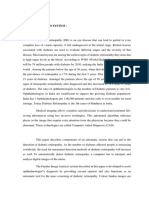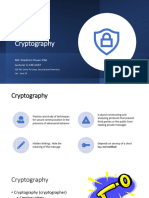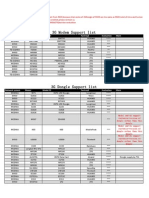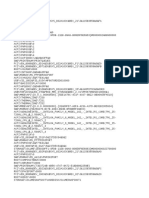Encryption/Decryption Application
Uploaded by
Ijarai IjaraiEncryption/Decryption Application
Uploaded by
Ijarai IjaraiIPHV1I20014X
International Journal Of Advanced Research and Innovations Vol.1, Issue .2
ISSN Online: 2319 9253 Print: 2319 9245
Encryption/Decryption Application
Niteesh Kumar1, K.Sameer Kumar2, B.Sanjay kumar3, T.Venkata Ramana4
1,2
Computer Science Department, SLCs Institute of engineering and Technology
Computer Science Department, spoorthy engineering college Professor & Head, Department of CSE, SLCS IET. Abstract This paper presents about Encryption/Decryption application that is able to work with any
type of file; for example: image files, data files, documentation filesetc. The method of encryption is simple enough yet powerful enough to fit the needs of students and staff in a small institution. Our application uses simple key generation method using AES (Advance Encryption Standard) algorithm. The key generation and Encryption are all done by the system itself after clicking the encryption button with transparency to the user. The same encryption key is also used to decrypt the encrypted binary file i.e. Symmetric key encryption is used. Keywords Encryption , Decryption,AES,Security,Files
Introduction Encryption is the most effective way to achieve data security. The process of plaintext and the encrypted data as the cipher text, which is representation of the original data in a different form. Key-based algorithms use an Encryption key to encrypt the message. There are two general categories for key-based Encryption: Symmetric Encryption which uses a single key to encrypt and decrypt the message and Asymmetric Encryption which uses two different keys a public key to encrypt the message, and a private key to decrypt it. Currently, there are several types of key based Encryption algorithms such as: DES, RSA,
Encryption hides the contents of a message in a way that the original information is recovered only through a decryption process. The purpose of Encryption is to prevent unauthorized parties from viewing or
modifying the data. Encryption occurs when the data is passed through some substitute technique, shifting technique, table references or mathematical operations. All those
processes generate a different form of that data. The unencrypted data is referred to as the
IJARAI.COM
JAN/2013
Page 109
IPHV1I20014X
International Journal Of Advanced Research and Innovations Vol.1, Issue .2
ISSN Online: 2319 9253 Print: 2319 9245
PGP, Elliptic curve, and others but all of these algorithms depend on high mathematical manipulations.
I. METHODOLOGY
2 25 70
5 62 112
862 1,231 3,841
1025 1,321 7,231
AES is an iterated block cipher with a fixed block length of 128 bits and a variable key length that can be 128, 192 or 256 bits. The algorithm, shown in Figure, passes plain text through a number of round transformations to produce the cipher. The algorithm allows 10, 12, or 14 transformations, depending on the key length. Each round transformation is composed of three distinct transformations, called layers. The first is the non-linear layer, Sub Bytes, which interchanges blocks of bytes within the word. The second is the linear mixing layer (Shift Rows + Mix Columns), and the third is the key addition layer (Add Round key). The transformations are
II. FILE TYPES
There are no limitations of the type of files accepted for encryption in this application, which means any type of a file such as data files, audio files, video files or image files can be encrypted by the application. This is because all the files are encrypted at the binary level. There is also no limitation of the size of the file that can be encrypted using this application, which provides flexibility to the user. The encrypted file can only be opened and viewed after it has been decrypted to its original file using the symmetric encryption key.
III. FEATURES
invertible, allowing the cipher text to be converted back to plain text if one has the key. The approximate time of encryption , decryption and size of encrypted file is in table I. Table I Origina l Encrypte Encryptio Decryptio n time(ms)
The interface of the application is simple enough to be used by any user The encryption is performed simply by choosing any file while decryption is executed by choosing an encrypted file with an appropriate key. The encrypted file is given with a unique extension .SNS which can be easily distinguishable from other files
d size(kb) n time(ms)
Size(kb )
IJARAI.COM
JAN/2013
Page 110
IPHV1I20014X
International Journal Of Advanced Research and Innovations Vol.1, Issue .2
ISSN Online: 2319 9253 Print: 2319 9245
and only the files with that extension will be decrypted. Encryption/Decryption will work with any file type (documents, image, videos, ppts ,exe ,etc.,) Encrypted file is uncrack able (as it is encrypted using AES algorithm) until and unless key is known. The Encryption and Decryption process will be very fast using this application Providing additional security than AES by encrypting the hexadecimal representation of data.
IV. SCOPE OF APPLICATION
by snooping about in their hard disk. A person or company may wish to transport to a distant location a computer which contains sensitive information without being
concerned that if the computer is examined en route (e.g. by foreign customs agents) then the
information will be revealed. Two individuals may wish to correspond by email on matters that they wish to keep private and be sure that no-one else is reading their mail. Can be used in small institution such as a small university for lecturers daily use of sending exam files and sensitive material such that the material can be encrypted and the file is sent in one e-mail while the encryption key is sent in another e-mail or via any secure
Companies often possess data files on employees such which as are
confidential, records,
medical etc.
salary
records,
Employees will feel safer knowing that these files are encrypted and are not accessible to casual inspection by data entry clerks (who may be bribed to obtain information on someone). Individuals may share working space with others, of whose honour they are not entirely sure, and may wish to make certain that in their absence no-one will find anything
communication channel. Porting this application to different platforms like windows phone , Android , Windows 8 ,etc., Further, providing security to the data while sending an SMS from a phone. The text which is to be sent will be encrypted at source and will
IJARAI.COM
JAN/2013
Page 111
IPHV1I20014X
International Journal Of Advanced Research and Innovations Vol.1, Issue .2
ISSN Online: 2319 9253 Print: 2319 9245
be decrypted at destination to get the original text back. Providing decompression compression which and decrease Figure 3 prompts the user to select the required files before encryption process is started. Figure 4 promts the user to enter the password and it is internally been converted to 128bit. Figure 5 gives a pop up saying the user that
V. IMPLEMENTATIONS
encrypted file size and conversion time.
the task is completed. Figure II
Figure I
The basic user interface of the application is shown in Figure 1. It allows the user to browse the file which is to be encrypted, the name to be given to the encrypted file. The buttons Encrypt, Decrypt and used for encryption and decryption of the file. Figure 2 shows the browsing of a file using a file dialog. Figure III
IJARAI.COM
JAN/2013
Page 112
IPHV1I20014X
International Journal Of Advanced Research and Innovations Vol.1, Issue .2
ISSN Online: 2319 9253 Print: 2319 9245
VI. CONCLUSIONS
The version of this application is V1.1. Most of the formatting instructions in this document have been developed and compiled using Eclipse and Java as programming language. REFERENCES [1] www.wikipedia.org Figure V [2] www.stackoverflow.com [3] www.way2java.com [4] http://docs.oracle.com/
Figure IV
IJARAI.COM
JAN/2013
Page 113
You might also like
- Simulation of Image Encryption Using AES AlgorithmNo ratings yetSimulation of Image Encryption Using AES Algorithm8 pages
- Using Steganography To Hide Messages Inside PDF FilesNo ratings yetUsing Steganography To Hide Messages Inside PDF Files34 pages
- GUI Implementation of Image Encryption and Decryption Using Open CV-Python Script On Secured TFTP ProtocolNo ratings yetGUI Implementation of Image Encryption and Decryption Using Open CV-Python Script On Secured TFTP Protocol9 pages
- Linear Algebra and Computer Application (Math149) Project On Cryptography (Hill Cipher Method)No ratings yetLinear Algebra and Computer Application (Math149) Project On Cryptography (Hill Cipher Method)11 pages
- Privacy Preserving of Data Files & Audio / Video Encryption - Decryption Using AES Algorithm100% (1)Privacy Preserving of Data Files & Audio / Video Encryption - Decryption Using AES Algorithm5 pages
- Implementation of Aes and Blowfish AlgorithmNo ratings yetImplementation of Aes and Blowfish Algorithm4 pages
- Image Encryption and Decryption Using Aes Algorithm100% (5)Image Encryption and Decryption Using Aes Algorithm7 pages
- Image Encryption and Decryption Using Symmetric Key in MatlabNo ratings yetImage Encryption and Decryption Using Symmetric Key in Matlab4 pages
- Machine Learning in The Field of Optical Character Recognition OCRNo ratings yetMachine Learning in The Field of Optical Character Recognition OCR5 pages
- Image Based Stegnography Using LSB Technique0% (1)Image Based Stegnography Using LSB Technique62 pages
- " Image Encryption Using AES ": End Semester Project Report OnNo ratings yet" Image Encryption Using AES ": End Semester Project Report On18 pages
- A Comprehensive Evaluation of Cryptographic Algorithms Des 3des Aes Rsa and Blowfish PDFNo ratings yetA Comprehensive Evaluation of Cryptographic Algorithms Des 3des Aes Rsa and Blowfish PDF8 pages
- Personalize Movie Recommendation System CS 229 Project Final Writeup0% (1)Personalize Movie Recommendation System CS 229 Project Final Writeup6 pages
- A Novel Video Stegonography Based On Non Uniform Rectangular PartitionNo ratings yetA Novel Video Stegonography Based On Non Uniform Rectangular Partition23 pages
- Image Steganography Project by Ajit Kumar Satapathy100% (4)Image Steganography Project by Ajit Kumar Satapathy32 pages
- Aes Algorithm For Encryption: Radhika D.BajajNo ratings yetAes Algorithm For Encryption: Radhika D.Bajaj6 pages
- Implementation of Blowfish Algorithm in Image Encryption and DecryptionNo ratings yetImplementation of Blowfish Algorithm in Image Encryption and Decryption14 pages
- DCT Based Video Watermarking in MATLAB PDFNo ratings yetDCT Based Video Watermarking in MATLAB PDF11 pages
- Secure Cloud Storage Using Different Algorithms in CryptographyNo ratings yetSecure Cloud Storage Using Different Algorithms in Cryptography10 pages
- Graphical Password Authentication - YaminiNo ratings yetGraphical Password Authentication - Yamini19 pages
- Data Storage Security in Cloud Computing Using AES Algorithm and MD5 AlgorithmNo ratings yetData Storage Security in Cloud Computing Using AES Algorithm and MD5 Algorithm6 pages
- Graphical Password Authentication Implemented in Web-Based SystemNo ratings yetGraphical Password Authentication Implemented in Web-Based System55 pages
- Encryption and Decryption of An Image Data and Information One Parallel Approach100% (1)Encryption and Decryption of An Image Data and Information One Parallel Approach4 pages
- Steganography Project Report For Major Project in B TechNo ratings yetSteganography Project Report For Major Project in B Tech74 pages
- Authentication by Encrypted Negative PasswordNo ratings yetAuthentication by Encrypted Negative Password3 pages
- Câmara Climática - Weiss - WT3 - WK3 - ENo ratings yetCâmara Climática - Weiss - WT3 - WK3 - E12 pages
- Bare Metal Virtual Machines and Containers in OpenstackNo ratings yetBare Metal Virtual Machines and Containers in Openstack8 pages
- Fundamentals of Computer Networks ECE 478/578No ratings yetFundamentals of Computer Networks ECE 478/57837 pages
- A Comprehensive Guide To Data Exploration: Steps of Data Exploration and Preparation Missing Value Treatment100% (2)A Comprehensive Guide To Data Exploration: Steps of Data Exploration and Preparation Missing Value Treatment8 pages
- SIPROTEC 4 7UT6 Differential Protection Relay For Transformers, Generators, Motors and BusbarsNo ratings yetSIPROTEC 4 7UT6 Differential Protection Relay For Transformers, Generators, Motors and Busbars9 pages
- Scrolling Text On LCD of AT89S52 Development BoardNo ratings yetScrolling Text On LCD of AT89S52 Development Board9 pages
- Cisco Bug_ CSCui80835 - ASA drops packet as PAWS failure after incorrect TSecr is seenNo ratings yetCisco Bug_ CSCui80835 - ASA drops packet as PAWS failure after incorrect TSecr is seen2 pages
- Revised Advanced Digital Systems Design 04 For PresentationNo ratings yetRevised Advanced Digital Systems Design 04 For Presentation13 pages
- Simulation of Image Encryption Using AES AlgorithmSimulation of Image Encryption Using AES Algorithm
- Using Steganography To Hide Messages Inside PDF FilesUsing Steganography To Hide Messages Inside PDF Files
- GUI Implementation of Image Encryption and Decryption Using Open CV-Python Script On Secured TFTP ProtocolGUI Implementation of Image Encryption and Decryption Using Open CV-Python Script On Secured TFTP Protocol
- Linear Algebra and Computer Application (Math149) Project On Cryptography (Hill Cipher Method)Linear Algebra and Computer Application (Math149) Project On Cryptography (Hill Cipher Method)
- Privacy Preserving of Data Files & Audio / Video Encryption - Decryption Using AES AlgorithmPrivacy Preserving of Data Files & Audio / Video Encryption - Decryption Using AES Algorithm
- Image Encryption and Decryption Using Aes AlgorithmImage Encryption and Decryption Using Aes Algorithm
- Image Encryption and Decryption Using Symmetric Key in MatlabImage Encryption and Decryption Using Symmetric Key in Matlab
- Machine Learning in The Field of Optical Character Recognition OCRMachine Learning in The Field of Optical Character Recognition OCR
- " Image Encryption Using AES ": End Semester Project Report On" Image Encryption Using AES ": End Semester Project Report On
- A Comprehensive Evaluation of Cryptographic Algorithms Des 3des Aes Rsa and Blowfish PDFA Comprehensive Evaluation of Cryptographic Algorithms Des 3des Aes Rsa and Blowfish PDF
- Personalize Movie Recommendation System CS 229 Project Final WriteupPersonalize Movie Recommendation System CS 229 Project Final Writeup
- A Novel Video Stegonography Based On Non Uniform Rectangular PartitionA Novel Video Stegonography Based On Non Uniform Rectangular Partition
- Image Steganography Project by Ajit Kumar SatapathyImage Steganography Project by Ajit Kumar Satapathy
- Implementation of Blowfish Algorithm in Image Encryption and DecryptionImplementation of Blowfish Algorithm in Image Encryption and Decryption
- Secure Cloud Storage Using Different Algorithms in CryptographySecure Cloud Storage Using Different Algorithms in Cryptography
- Data Storage Security in Cloud Computing Using AES Algorithm and MD5 AlgorithmData Storage Security in Cloud Computing Using AES Algorithm and MD5 Algorithm
- Graphical Password Authentication Implemented in Web-Based SystemGraphical Password Authentication Implemented in Web-Based System
- Encryption and Decryption of An Image Data and Information One Parallel ApproachEncryption and Decryption of An Image Data and Information One Parallel Approach
- Steganography Project Report For Major Project in B TechSteganography Project Report For Major Project in B Tech
- Bare Metal Virtual Machines and Containers in OpenstackBare Metal Virtual Machines and Containers in Openstack
- A Comprehensive Guide To Data Exploration: Steps of Data Exploration and Preparation Missing Value TreatmentA Comprehensive Guide To Data Exploration: Steps of Data Exploration and Preparation Missing Value Treatment
- SIPROTEC 4 7UT6 Differential Protection Relay For Transformers, Generators, Motors and BusbarsSIPROTEC 4 7UT6 Differential Protection Relay For Transformers, Generators, Motors and Busbars
- Scrolling Text On LCD of AT89S52 Development BoardScrolling Text On LCD of AT89S52 Development Board
- Cisco Bug_ CSCui80835 - ASA drops packet as PAWS failure after incorrect TSecr is seenCisco Bug_ CSCui80835 - ASA drops packet as PAWS failure after incorrect TSecr is seen
- Revised Advanced Digital Systems Design 04 For PresentationRevised Advanced Digital Systems Design 04 For Presentation

























































































